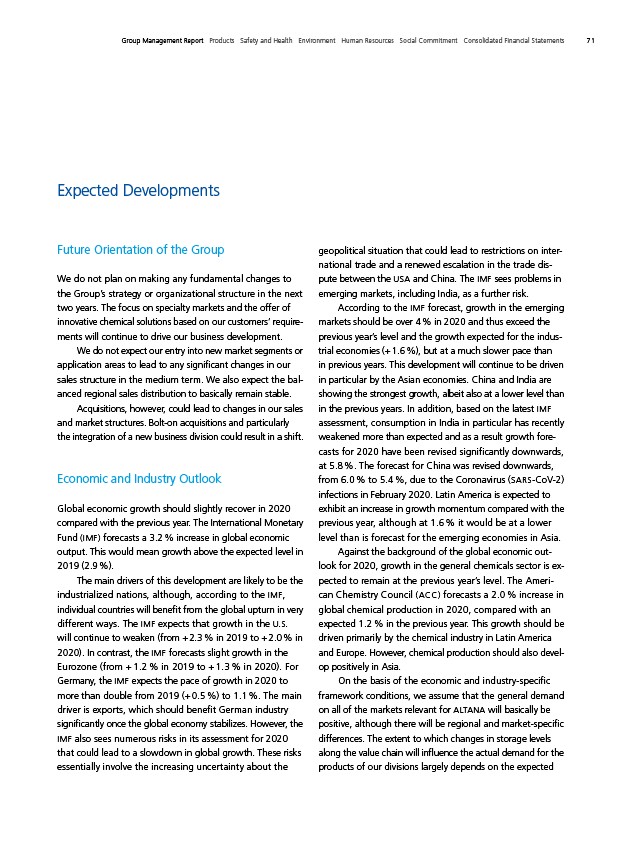
Group Management Report Products Safety and Health Environment Human Resources Social Commitment Consolidated Financial Statements 71
Expected Developments
Future Orientation of the Group
We do not plan on making any fundamental changes to
the Group’s strategy or organizational structure in the next
two years. The focus on specialty markets and the offer of
innovative chemical solutions based on our customers’ requirements
will continue to drive our business development.
We do not expect our entry into new market segments or
application areas to lead to any significant changes in our
sales structure in the medium term. We also expect the balanced
regional sales distribution to basically remain stable.
Acquisitions, however, could lead to changes in our sales
and market structures. Bolt-on acquisitions and particularly
the integration of a new business division could result in a shift.
Economic and Industry Outlook
Global economic growth should slightly recover in 2020
compared with the previous year. The International Monetary
Fund (IMF) forecasts a 3.2 % increase in global economic
output. This would mean growth above the expected level in
2019 (2.9 %).
The main drivers of this development are likely to be the
industrialized nations, although, according to the IMF,
individual countries will benefit from the global upturn in very
different ways. The IMF expects that growth in the U.S.
will continue to weaken (from + 2.3 % in 2019 to + 2.0 % in
2020). In contrast, the IMF forecasts slight growth in the
Eurozone (from + 1.2 % in 2019 to + 1.3 % in 2020). For
Germany, the IMF expects the pace of growth in 2020 to
more than double from 2019 (+ 0.5 %) to 1.1 %. The main
driver is exports, which should benefit German industry
significantly once the global economy stabilizes. However, the
IMF also sees numerous risks in its assessment for 2020
that could lead to a slowdown in global growth. These risks
essentially involve the increasing uncertainty about the
geopolitical situation that could lead to restrictions on international
trade and a renewed escalation in the trade dispute
between the USA and China. The IMF sees problems in
emerging markets, including India, as a further risk.
According to the IMF forecast, growth in the emerging
markets should be over 4 % in 2020 and thus exceed the
previous year’s level and the growth expected for the industrial
economies (+ 1.6 %), but at a much slower pace than
in previous years. This development will continue to be driven
in particular by the Asian economies. China and India are
showing the strongest growth, albeit also at a lower level than
in the previous years. In addition, based on the latest IMF
assessment, consumption in India in particular has recently
weakened more than expected and as a result growth forecasts
for 2020 have been revised significantly downwards,
at 5.8 %. The forecast for China was revised downwards,
from 6.0 % to 5.4 %, due to the Coronavirus (SARS-CoV-2)
infections in February 2020. Latin America is expected to
exhibit an increase in growth momentum compared with the
previous year, although at 1.6 % it would be at a lower
level than is forecast for the emerging economies in Asia.
Against the background of the global economic outlook
for 2020, growth in the general chemicals sector is ex-
pected to remain at the previous year’s level. The American
Chemistry Council (ACC) forecasts a 2.0 % increase in
global chemical production in 2020, compared with an
expected 1.2 % in the previous year. This growth should be
driven primarily by the chemical industry in Latin America
and Europe. However, chemical production should also develop
positively in Asia.
On the basis of the economic and industry-specific
framework conditions, we assume that the general demand
on all of the markets relevant for ALTANA will basically be
positive, although there will be regional and market-specific
differences. The extent to which changes in storage levels
along the value chain will influence the actual demand for the
products of our divisions largely depends on the expected